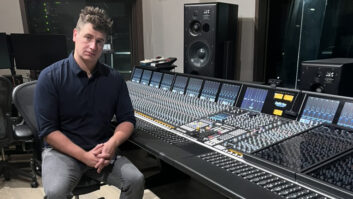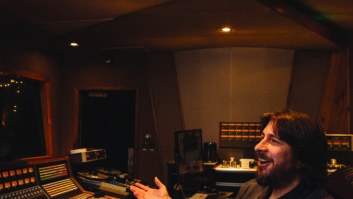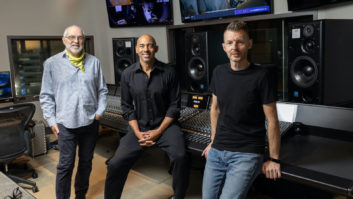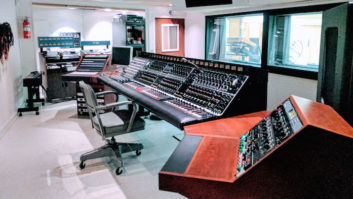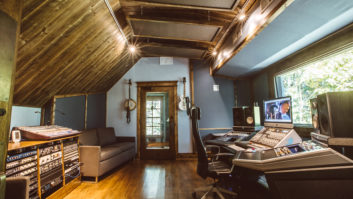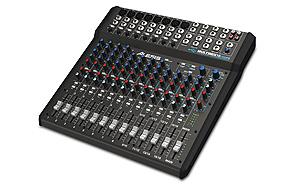
Console manufacturers have adapted to our evolving workflows by offering a range of solid products aimed anywhere from large-format studio installations to desktop audio production. Here, we present manufacturers’ current offerings, listed alphabetically. These consoles and audio controllers include a variety of features such as embedded converters, onboard DSP and effects, FireWire, USB and analog I/O, modular design and more. All in these products offer something for every budget and need, so dig in and enjoy.
Alesis MultiMix 16 USB FX
Alesis’ MultiMix 16 USB FX is a 16-channel mixer with built-in DSP effects (reverb, delay and phaser) and a footswitch bypass control that has eight XLR inputs with gain trim, switchable highpass filters and 48-volt phantom power. It offers ¼-inch line-level inputs on all 16 channels, a high-impedance input on channel 2 and a tape RCA stereo input. Channels 1 through 8 feature 3-band EQ (with sweepable parametric midrange control on channels 1 through 4), while channels 8 through 16 have 2-band EQ. The MultiMix 16 USB FX also contains an aux out and stereo returns, as well as insert jacks on channels 1 through 4. The MultiMix 16 USB FX, MultiMix 8 USB 2.0 and MultiMix 8 USB all contain a USB recording interface (16-bit, 44.1/48kHz bidirectional stereo) for Mac and PC that requires no software drivers. Main and headphone outputs have independent level controls, and the mixer includes Cubase LE software.

AMS Neve Genesys
AMS Neve hand-builds the modular Genesys console in its UK factory, combining analog design and true Neve preamp circuitry with hands-on DAW control and connectivity for Pro Tools, Logic, Nuendo and more. The Genesys’ basic 16-fader configuration comprises 16 channels of mic/line preamps, 16 channels of DAW mixing, 32-channel analog summing at mixdown, eight auxiliary buses, eight group buses and 5.1 monitoring. Every switch is “soft,” so every routing decision and switch setting can be saved and instantaneously reset. The console can also recall optional Neve analog EQ and dynamics cassettes. The Genesys is expandable up to 64 faders/128 inputs with Encore automation, Total Recall, transformers on mic preamps and Neve AD/DA converters.
The Neve 88D digital console uses classic Neve transformer mic inputs and Gigabit-linked Super-High-Definition converters. Its DSP engine is capable of mixing 1,000 tracks at 96 kHz with classic Neve 1081R mic preamplifiers, dedicated 8.1 surround monitoring of multiple sources and the latest Encore Plus automation. It also offers high-PCM sampling rates, DXD mixing and 40-bit floating-point processing. Its conventional channel strips with touch-sensitive illuminated logicators provide a simple and direct method of control feedback. A knob-per-function center panel aids sweet-spot mixing, while a “small fader” path and a simple layer structure are designed to provide easy access to large numbers of channels. The 88RS analog console is designed for 5.1 surround sound production as it has no VCAs, uses in-line console architecture and offers four main output faders (L/R, C, S and Ls/Rs). The 88RS is supplied with an Encore Plus automation system and has motorized large and small faders, two faders per channel strip, AFL surround solo monitor, enhanced “S” channel strip, spectral Neve formant equalization, Neve soft-knee compression, 24-step precision volume control and remote mic amp option. The addition of the stem mixer and 8-track scoring panel makes it a viable choice for scoring, music recording and mixing.
Based on API’s vintage 1604 console, the all-discrete 1608 small-topology analog console ($89,800 for 32-channel console; $49,900 for 16-channel console) features 16 input channels with mic pre, 12 550A equalizers, four 560 equalizers, eight echo returns, a complete center facilities section, 16 manual faders and one stereo fader.
The Vision (pricing by quotation) all-discrete surround mixing and recording console features comprehensive central facilities, as well as simultaneous surround and stereo assign and panning on each fader. Said to be the only analog console designed from the ground up for surround work, the API Vision offers resettable switch automation and bus assign, a dedicated 5.1 mix bus and API’s Vision Automation with two 100mm motorized faders on each channel.
The Legacy Plus (pricing by quotation) console features 24 main buses, 12 auxes, three stereo buses and dual faders on each input. With a selection of three different API equalizers, 212 mic pre’s and 200 Series dynamics modules, this all-discrete analog console is custom built to order from 16 to 96 channels. API’s Vision automation may be fitted as one of many options.

Audient ASP8024
Designed by David Dearden, Audient’s ASP8024 (from $32,000 for a 24-channel with Dual Layer Control) combines the company’s analog circuitry with DAW control and automation, providing a centerpiece for production studios and education facilities. Each input channel features Audient’s Class-A preamp and 4-band EQ. The console features 24-bus routing, 12 auxes, two dedicated cue sends, four stereo returns, stereo bus compressor and a comprehensive monitor section.

Avid S5 Fusion
The AvidS5 Fusion (call for price quote) offers a dedicated DSP engine that is expandable up to 116 channels and complete EUCON Hybrid control, allowing for deep tactile control up to five different DAWs, as well as the console’s own DSP channels, all at once. The S5 Fusion control surface is customizable from eight to 56 channel strips. Each channel strip includes a multiformat, motorized fader, as well as eight touch-sensitive knobs for EQ, filter, compressor, expander/gate, aux sends and pan control that can also control DAW functions, including adjusting TDM, VST and AU plug-in parameters. High-resolution TFT displays offer instant visual feedback on metering, track info, routing, EQ, dynamics and more. The S5 Fusion also offers 256 channels of MADI connectivity (expandable to 512), SnapShot Recall, customizable layouts, Total Automation, user-definable Spill zones and mixing in up to 7.1 surround with twin joysticks and up to 26 analog outputs.
The 24-channel C|24 ($9,995 MSRP) provides hands-on control of Pro Tools mixing, recording and editing, with high-quality analog inputs and a 5.1 analog monitor section with trimable inputs and outputs for use with Pro Tools I/O. C|24 features 24 bankable channel strips, each with a touch-sensitive, motorized fader and dedicated mute, solo, select, input, record, EQ, dynamics, insert, send and automation buttons. A 6-character dual-row LED scribble strip displays channel names, plug-in parameters, sends, panning and other editing functions. It offers 24 high-quality rotary encoders with LED rings; 16 mic/line/DI preamps with highpass filters; variable input gain for direct mic, instrument and line-level connections (via DB-25) for recording through an Avid audio interface; an 8-channel stereo line submixer, which can be routed directly to the monitor section; and built-in talkback mic and inputs for remote talkback and listen-back. Its external power supply allows for a more streamlined console design.

Behringer XENYX UFX1604
Behringer’s XENYX UFX1604 is a 16-input, 4-bus analog mixer with a 16×4 USB/FireWire interface (24-bit/96kHz) supporting Windows XP/Vista/7 and Mac OS X, and a 16-track USB recorder. It also has eight XENYX mic preamps with individual phantom-power switches, eight compressors with “one-knob” functionality and control LED, 4-band British-style EQs with two semi-parametric midrange bands, and dual stereo effects processors with 16 editable presets, including reverb, chorus, flanger, delay, pitch shifter, multi-effects, Tap function and storable user parameter settings. An illuminated MIDI Transport section provides remote control over a DAW or sequencer. It also has two hi-Z inputs, eight channel inserts, balanced main mix outputs on ¼-inch TRS and XLR connectors, four aux sends per channel (all pre- or post-fader-switchable), four stereo aux returns and separate CD/tape input. The XENYX UFX1604 also offers Solo-In-Place with PFL/AFL function, and talkback and monitor sections.

Fairlight EVO M-Series
Fairlight’s (fairlightus.com) new EVO M-Series is a complete music production system incorporating recording, mixing, MIDI, sampling, plug-ins and video playback for scoring. Its processing heart is Fairlight’s single-chip FPGA engine, maxing out at 192 disk tracks, 230 channels of mixing and video up to HD quality. Every channel provides 4-band parametric EQ, highpass and lowpass filter, gate, compressor and limiter. In addition, the system supports the full range of VST plug-ins and instruments. The worksurface employs the highly adaptable Xynergi keyboard as central control panel, and includes faders and a range of optional tactile panels. Customization supports widely different sizes, layouts and specialist panels tailored to users’ differing workflows. One version offers a built-in music keyboard. Furthermore, EVO saves everything as a single file.
The FocusriteControl 2802 ($5,999.99), the first product jointly created by Focusrite and Audient, is an analog recording console and DAW control surface in one. Its Dual-Layer technology allows the user to jump between analog mixing and DAW control. In a single surface, the Focusrite Control 2802 integrates state-of-the-art summing of 28 inputs, comprehensive monitoring, stereo master bus compression and control over every major DAW. The Control 2802 also offers eight Class-A microphone preamplifiers, ultra-low-noise analog circuitry with reportedly extreme high-frequency extension, Ethernet-based control, and DAW and console automation.
Harrison950m analog console is designed for the DAW-based studio, with an ergonomic frame design that accommodates DAW peripherals. It comes in a modular design with 12, 16 and 24-channel frames standard. The new console incorporates a massive linear power supply, robust ground-plane design, all balanced connections, gold-plated switches, through-hole components and high-headroom summing buses. It also has two master buses comprising one 32 Series–style transformer-balanced output and one Series 12–style electronically balanced output. The 950m further offers two studio feeds, talkback, oscillator and headphone feeds.
The mc²90 (pricing starts at $350,000) is Lawo’s flagship console, with a modular design and a freely configurable desk surface with up to 200 faders that provide direct access to all system parameters. The mc²90 promises intuitive operation of all audio modules, and is equipped with high-performance DSP cards for excellent signal processing.

Lawo mc²66
The mc²66 (pricing starts at $250,000) provides 512 DSP channels, 144 summing buses and top-quality signal processing. For intuitive operation, the mc²66 offers its newly developed operation philosophy, “assign at destination,” which provides for a fast and secure interference, even in critical live situations. The new redundantly designable MKII Router has a routing capacity of up to 8,192 crosspoints and a fully integrated control system for high system reliability. With the Extra Faders option (supported with Version 4.14 software release; orders are accepted), an additional eight faders are available.
The 16-channel MackieOnyx 1640i ($1,899.99 MSRP) FireWire production mixer combines the benefits of a computer interface with the tactile, hands-on control of an analog mixer. It derives its sonic performance from 16 Onyx mic preamps and Perkins EQ. Mackie qualifies the 1640i for use with all major DAWs, including Pro Tools M-Powered 8; the mixer can send channels, aux sends, groups or master L/R signals discreetly to a Mac or PC for recording. Users can also return all 16 channels back to the mixer for mixdown. Other models in Mackie’s Onyx-i Series include the 1620i, 1220i and 820i.
The Mackie 1604-VLZ3 ($1,149.99) 16-channel/4-bus compact mixer builds on the legacy of Mackie’s best-selling 1604-VLZ Pro mixer. Sixteen studio-quality, XDR2, second-generation mic preamps, along with redesigned 3-band active EQ circuitry (with sweepable midrange), give the 1604-VLZ3 its sound quality. All channels feature insert points and line-level inputs for extreme versatility. The Rotopod option allows for two desktop and three rackmounted configurations. A new multivoltage power supply allows the 1604-VLZ3 to be used anywhere in the world. Other models in Mackie’s VLZ3 Series include the 1642-VLZ3, 1402-VLZ3, 1202-VLZ3, 802-VLZ3 and 402-VLZ3.
The Mackie Control Universal Pro ($1,399.99 MSRP) control surface for music production software offers nine motorized, touch-sensitive Penny + Giles faders, eight V-Pots and more than 50 master buttons for adjusting parameters. Unlike generic MIDI controllers, the MCU Pro employs a sophisticated communication protocol that delivers ultra-precise control, makes setup easy—no mapping is required—and enables users to see their mix in action with real-time visual feedback via a large backlit LCD and eight LED rings. Users can expand their control options with the Mackie Control Extender Pro.
Manley Labs’ 16×2 MIC Mixer provides 16 mic preamps with up to 60 dB of pure Manley gain. Each channel features pan and mix level controls on silent conductive-plastic rotary faders, with solo, mute, insert and phase-reverse switches. These 16 solid-state channels are summed to an all-vacuum tube stereo bus (complete with flexible monitor and metering sections), and then coupled to the outputs via custom-wound Manley transformers. Audiophile components are used throughout, and a robust outboard power supply reduces noise and heat. For versatility, each channel has a combo jack input that allows it to serve double-duty as a line-level summing mixer. The 16×2 is available in MIC ($9,900), LINE ($9,000) and 8 MIC + 8 LINE ($9,500) versions.
Merging Technologies’ Ramses MSC console control system offers a fully integrated multitrack audio recording, editing, processing and mixing environment. The system is scalable from 16 to 256 simultaneous input and output channels (512 I/O), with a 256 user-configurable bus structure. The dedicated automation section allows for control of all mixing parameters, and the different automation states can be split and assigned to faders, pans, EQ, dynamics, etc., independently. The monitor section offers external source monitoring and comprehensive facilities such as summing and down-mixing for all supported formats. The control surface offers tactile control with both channel strip and centralized control of EQ, dynamics, aux and pans. Full support of VST plug-ins is freely assignable on any input, bus or output. Touch-sensitive moving faders and dual-concentric encoders means all mix elements can be automated.
Nady Systems offers the MM-15USB ($199.99 MSRP) desktop mini-mixer with a built-in USB 1 audio interface that comes in 7×8-inch durable-steel casing. It uses SMD technology for compact design and accommodates up to 15 simultaneous inputs and 10 outputs (including the complete USB interface), and has two mono channels with balanced mic and line inputs and two stereo channels with line and RCA inputs. Each channel has trim, 3-band EQ, aux send, pan and level controls with peak indicator LEDs. The MM-15USB has a stereo mini-jack input that accommodates iPods and MP3 players, as well as a stereo mini-jack output. It uses ultra-low-noise mic preamps for optimum signal integrity; offers a full-spectrum frequency response with wide dynamic range and superior headroom; separate main mix, control room and headphone outputs; stereo aux; return inputs with level control; tape in/out RCA connectors; and dual 4-segment LED bargraph meters.
The PhonicDigital Mixer ($2,749.99 MSRP) is a 16-channel mixer (16 mono mic/line with insert points and grouped phantom power) with XLR and ¼-inch inputs on each channel. It has 17 100mm motorized faders, of which 16 faders offer three layers of operation (channel, aux/group and multi). It also has eight balanced ¼-inch phone jack multi outputs (eight aux and eight group buses are assignable to multi outputs), and XLR main and control room outputs. All input and output channels offer delay, EQ and dynamics processing, 4-band parametric EQs, multi outputs and main outputs. Two stereo digital FX processors are assignable to input channels and aux buses. The unit also includes a 40-bit floating-point digital signal processor, AES/EBU inputs and outputs, an internal digital sampling rate of up to 24-bit/96 kHz, a full-color touchscreen, and an optional FireWire and USB 2 expansion card (16-in, 16-out) for multitrack recording.
PreSonus offers three StudioLive digital mixer models. All have built-in, tightly integrated FireWire audio interfaces that work with any recording application that supports ASIO or Core Audio. The mixers are bundled with PreSonus Capture multitrack recording software, Studio One Artist DAW software, and Virtual StudioLive bi-directional control/librarian software for Mac and Windows. StudioLive mixers feature PreSonus XMAX Class-A solid-state preamps and high-definition converters (118dB dynamic range). Their distinctive Fat Channel processing section provides a separate compressor, limiter and expander (as well as gate in the two larger models); multiband parametric EQ; highpass filter; panning; and bus assignment. Two internal effects buses serve dual-stereo 32-bit floating-point effects processors for reverb and delay effects. You can save/recall mixer Scenes and save/recall and copy/paste channel strip settings. The 24.4.2 and 16.4.2 also can be controlled from an iPad using free PreSonus SL Remote software.

PreSonus StudioLive 16.02
The StudioLive 24.4.2 ($3,999.95 MSRP) offers 24 input channels with preamps, four subgroups, 10 aux buses, eight 31-band graphic EQs and a 32×26 FireWire interface. The StudioLive 16.4.2 ($2,499.95 MSRP) provides 16 input channels with preamps, four subgroups, six auxes, eight 31-band graphic EQs and a 32×18 FireWire interface. Finally, the StudioLive 16.02 ($1,599.95 MSRP) has 12 mono input channels with preamps, two stereo channels with line inputs only, four auxes, one stereo graphic EQ (on the mains) and a 16×16 FireWire interface. The 16.0.2 also has MIDI I/O, serves as a MIDI interface and offers MIDI control over main level, effects and scene recall.

Roland V-Studio 700
The RolandV-Studio 700 ($3,795 MSRP) DAW is a complete workstation solution that is fully integrated with Cakewalk SONAR; a SONAR X1 upgrade download link is also provided. The V-Studio 700 can also be used as software that supports Mackie Control protocol. It features high-quality I/O, a control surface, and ARX expansion with a motorized, touch-sensitive 100mm faders and a 64-bit mix engine. V-Studio 700 system components include VS-700C V-Studio Console, VS-700R 18/24 I/O module with 24-bit/192kHz I/O, a Fantom VS hardware synthesizer (based on Roland’s Fantom Series) and SONAR 8 Producer software with a 64-bit mix engine. Cakewalk’s Dimension Pro and Rapture software synthesizers are also included. The VS-700C V-Studio Console offers hands-on editing control with tight integration inside of SONAR, and includes exclusive technologies like AudioSnap, V-Vocal, Smart MIDI Tools and Active Controller Technology.
Launched in 2004, Solid State Logic’s AWS (Analogue Workstation System) combines SSL SuperAnalogue console technology with comprehensive DAW control hardware in a single worksurface. The AWS is available with 24 inputs (AWS 924) or 48 inputs (AWS 948) within a 24-fader frame. Both models have 24 SSL SuperAnalogue mic pre’s, classic SSL dual-curve EQ on every channel, two assignable SSL dynamics, stereo bus compressor, Total Recall, full 5.1 monitoring, onboard SSL Automation (the A-FADA mode in which motorized analog faders follow DAW automation data), Ethernet connectivity, heavy-duty DAW transport, V-Pot multifunction encoders with position-indicating LED, digital Scribble Strips, DAW fader mode, global and channel routing control, built-in TFT display for advanced plug-in editing, and a Logictivity interface for project session management.
SSL’s C200 HD provides the latest adaptation of SSL’s in-line console heritage with a dedicated “knob per function” control surface. A special Mobile configuration is also available for compact studio or mobile installations. The C200 HD features analog-style control, dual faders (large and small) per channel strip, flexible in-line channel configurations, 12 main buses for stereo/5.1 audio subgroups, two Program outputs (5.1 and stereo), 48 multitrack buses with individual gain trim, independent pre- and post-fader direct outputs, 12 aux buses with odd/even stereo linking, 12 stereo FX returns, sample-independent processing with options for 48- or 96kHz operation, dedicated processing per channel strip, EQ and dynamics DSP emulations, full 5.1 facilities for surround mixing, and comprehensive dynamic automation and integrated 4-port machine control system.
Duality combines an analog path and signal processing with DAW control, all within a single hardware surface. Duality is available in 24, 48, 72 and 96-fader configurations, expandable in bays of 24 (up to 96) and with producer and patch options. It has dual mic pre’s (SuperAnalogue and Variable Harmonic Drive/VHD circuit). Its split-signal flow architecture provides flexible routing and processing. Duality offers complete 5.1 surround support, with a full range of monitor calibration and setup options. Dual workstation support is possible through Ethernet connectivity. New dual-layer DAW control enables Duality to control two independent DAWs at once, with seamless switching of hardware surface controls between manipulations of each DAW layer. Duality further uses Channel TFT screens and offers SSL’s Logictivity Session Management using the Java-based SSL Logicitivity Duality Remote Browser.
SSL’s Matrix is a SuperAnalogue 16-channel, 40-input mixing console with in-built signal router and 16 motorized faders allowing multilayer DAW control. Installing the Surround Monitoring option will convert the external-source inputs Ext A and B input from stereo to 5.1, and the stereo monitor outputs into two 5.1 outputs. This provides two input stems for 5.1 monitoring and two sets of 5.1 speakers, which you can switch between and control using the console’s center section. Matrix also features 16 mono line channels with two separate inputs per strip, a 32x16x16 insert router for up to 16 external processing devices, stereo aux send and four mono sends per channel, an “Input to Cue Stereo” function that doubles the mixdown channel count, stereo digital I/O (S/PDIF, AES/EBU) with SSL converter technology and more.
SSL also offers Nucleus, which combines DAW control via Ethernet, SuperAnalogue monitoring, analog mic pre’s and USB audio interface and bundles SSL Duende Native plug-ins. Users can connect up to three different DAWs at once and switch between them with a single button-push. Nucleus uses either HUI or MCU protocols to ensure compatibility with Pro Tools, Logic, Cubase/Nuendo and other DAW applications, and can transmit MIDI CC data. Hardware controls can be customized for all major DAW and plug-in parameters. Two banks of eight channels each provide 100mm motorized faders, fully user-definable soft keys and V-Pots, dedicated Select/Solo/Cut buttons and 10-point channel level meters. Center-section DAW controls provide large heavy-duty transport buttons, a jog/shuttle wheel, bank/channel/layer selection and navigation, global DAW parameter selection and additional USB keyboard emulation buttons. System configuration is via a remote “SSL Logictivity” browser.
Finally, SSL’s X-Desk combines a 16-channel SSL SuperAnalogue summing mixer with a compact analog audio hub. It includes smooth 100mm faders, comprehensive artist and studio monitoring with Dim and Cut buttons, stereo and mono aux sends, channel and master bus inserts and accurate bargraph level metering. For easy integration into an existing studio, X-Desk can be used as a desktop mixer with removable rack ears for standard 19-inch rackmounting (7U space required). The X-Desk is hand-built in the UK with an all-metal chassis and high-quality controls and components. Up to eight X-Desks or X-Desk and X-Rack combinations can be cascaded via D-Sub connection to expand up to 160 inputs on mixdown.

Stagetec AURUS
The StagetecAURUS combines the direct access of a conventional analog desk with the configurability, flexibility and the electro-acoustic parameters of an advanced digital console. Configured as an inline console for recording or straight production console for music mixing, the AURUS offers full dynamic automation and multiple machine control via 9-pin, LTC or MIDI. Its modular design enables customers to select the size of its control surface, from 24 to 96 channel strips in units of eight channel strips, as well as the amount of signal processing to give the required number of DSP channels and buses. True 40-bit floating-point architecture offers precision EQ and dynamics in every channel. The TrueMatch digital microphone preamps (which are modular and can be specified by the customer) offer unparalleled response with a dynamic range of more than 158 dB. I/O is provided through the NEXUS, offering a whole contingent of I/O possibilities from analog, AES, MADI, ADAT, TDIF, Dolby D and more.
The Custom Series 75 from Australia’s Studios 301 Manufacturing (dist. in the U.S. by Vintage King Audio) presents a combination of classic and modern circuitry in one console. The console’s manufacturer re-created classic Neve circuitry, keeping faith with the original while taking advantage of modern assembly methods. The original circuits have only been changed where justified by an improvement in reliability or performance. The console’s two stereo buses allow for maximum flexibility, and the 2081 in-line channel modules feature a blend of the best features of Neve’s 1073 and 1081 modules. The console’s master section includes two 2254 compressors, four stereo reverb returns, eight recallable scenes, monitoring of up to 12 sources simultaneously and comprehensive 7.1 monitoring. The Series 75 is available in a 16/24/32/40/48/56/64-module chassis (prices range from $46,990 to $125,590 MSRP; pricing is dependent upon configuration).

Tascam DM-4800
The TascamDM-4800 64-channel digital console offers analog and digital I/O, and includes a “fat channel” strip that provides instant access to 4-band parametric EQ, dynamics and aux controls available for the first 48 channels. It has 24 studio-grade mic preamps; more can be added via expansion cards with external preamps. A completely configurable 24-bus routing system allows users to re-patch the board at the flick of a switch. With a single button press, the Remote layer provides a 24-fader control surface for control of workstations such as Pro Tools, Logic, SONAR, Digital Performer, Cubase and Nuendo. The optional IF-FW/DM mkII interface card provides 32 channels to and from a computer at up to 96 kHz over a single FireWire cable. An optional surround monitoring card provides downmixing, bass management and level control for mixing in up to 6.1 surround.
The DM-3200 has per-channel multifunction LED ring encoders, comprehensive DAW control, flexible routing, robust data backup and restoration, mix storage using compact Flash media and more. The DM-3200 features 32 full-featured channels and 16 returns for a total of 48 channels at mixdown, including its full 96kHz/24-bit audio resolution. It has 4-band fully parametric EQ and dynamics on every channel, as well as two effects processors, each capable of running its built-in TC Works Reverb processor. Surround mixing is available with up to 6.1 channel panning, and optional IF-SM/DM expansion card adds surround monitoring and downmixing. With the addition of an optional expansion card, the IF-FW/DM FireWire interface, the DM-3200 becomes a 24-channel computer audio interface. Built-in HUI and Mackie Control emulation allow the console to function as a flexible control surface for workstation software. It also offers cue mixing, talkback, microphone preamps and automation.
TL Audio offers the M4 tube console, available in 16/24/32/40/48-channel options, is compatible with all DAWs, and has 8-channel ADAT interface options, a 24-bit/96kHz mix output option, 100mm K Series faders, 4-band equalizers with bypass, four auxiliary sends that are selectable pre/post, channel mute and PFL, studio monitoring and stereo metering. Users can track direct channel outputs with level control, and levels are switchable between +4 and -10 dBu.
TL Audio’s VTC (Valve Technology Console) is a fully modular in-line multitrack mixer that offers all the benefits of the compact 8-bus/multiple tape output format, but with the advantage of TL Audio’s critically acclaimed valve circuitry, which forms an integral part of the channel, monitor, group and master section signal paths. VTC is available in configurations from 16 channels to 56 channels, with an optional bargraph meter bridge, and combines the classic warmth of tubes with the functional demands of modern music production. Every Channel and Mix B preamp incorporates an ECC83/12AX7A tube stage, as do the Group, Mix B and Stereo master mix amplifiers. Each tube stage in the VTC is run from a 250VDC stabilized power source. Built around an extra-tough steel frame, each channel is modular and connects via two multi-way connectors mounted on a rigid backplane, allowing for easy removal and replacement.
Toft Audio Designs’ (dist. by pmiaudio.com) ATB Recording consoles include the ATB-32, 24, 16, 08M and 04M. All ATB consoles feature Malcom Toft–designed mic preamps and Series 80B EQs. The Series 80B EQ was primarily designed by Toft’s ears rather than by measuring equipment, owing to Toft’s background as a recording engineer. The ATB Series’ 80B EQ uses the original Series 80B’s circuitry and same type and specification of components to reproduce its sound. The unique split/in-line design means that in addition to the mic/line inputs, users also have the same number of in-line monitor returns always assigned to the stereo bus, and eight more monitor returns in the “split” monitor section. On the ATB-32, this means 72 inputs between main channels and monitor returns; add eight stereo effects returns, and the ATB-32 can offer up to 88 inputs on mixdown.
Tonelux (dist. by pmiaudio.com) offers its Series 28 audio consoles designed by Paul Wolff, whose designs include all-discrete electronic components. Wolff’s unique gain staging and op amp topology are said to result in nearly imperceptible transient distortion, yet maintain the harmonic warmth characteristic of “classic” tone. The 8-bus 1628 console features 16 MP1A discrete mic preamps, 16 EQ4P 4-band proportional equalizers and 16 MX2 line input modules. Other features include four aux sends, eight effects returns, group and 2-bus metering, and switchable peak or VU. The stereo outputs are mixed through Wolff’s all-discrete summing amps. Full control room and talkback facilities are via the CR2 and TB1 modules. The 1628 console comes with a 192-point TT patchbay. Tonelux’s moving fader automation system, Shadowmix, can be easily integrated into the console. Additionally, there is a completely wired D-Sub I/O panel.

Trident Series 82
With Trident’s (dist. by pmiaudio.com) 24-bus all-modular Series 82, Malcolm Toft offers his newest ultra-quiet circuit designs, featuring Lundahl transformer-balanced mic inputs and 2-mix outputs. The Series 82 equalizer features four overlapping sweepable bands with the high and low bands being peak or shelving switchable, the high-mid and low-mid bands with switchable Q, and highpass filter sweepable from 30 to 500 Hz. It also features Toft’s split/inline design; in addition to the inline monitor returns, there is also a paralleled 24-channel split monitor section to the right of the master section, adding 24 more inputs on mixdown. All monitor returns feature high (12kHz, +/-15dB) and low (80Hz, +/-15dB) fixed-frequency shelving equalization filters, with the split section offering a sweepable midrange band. Additionally, the Series 82 dual-input module offers eight effects sends, all pre/post-switchable, and four stereo effects return with 3-band fixed-frequency equalization. Input configurations up to 48 are available.
The YamahaDM2000VCM ($20,999 MSRP) digital console combines a multitude of surround mixing and monitoring functions on its control surface with a maximum of 96 inputs and 22 mixing buses. It offers transparent sound quality thanks to its head superb amp, 24-bit AD/DA and 96kHz sampling. The DM2000VCM also integrates with DAWs such as Nuendo, and includes VCM plug-ins including EQ, compressors, tape saturation and guitar effects, along with the REV-X reverb algorithm initially introduced in the SPX-2000. The Yamaha DM2000VCM offers up to 96 simultaneous inputs, and all 96 input channels include 4-band parametric EQ, gating, compression/limiting and up to 453 ms of delay with variable feedback. The output section offers 22 buses: eight group buses, 12 auxiliary buses and the main stereo bus. Eight of the 12 auxiliary buses can be used as surround effect sends, and its Unity function automatically sets the auxiliary buses to nominal (0dB) level so they can be used as additional group buses.
